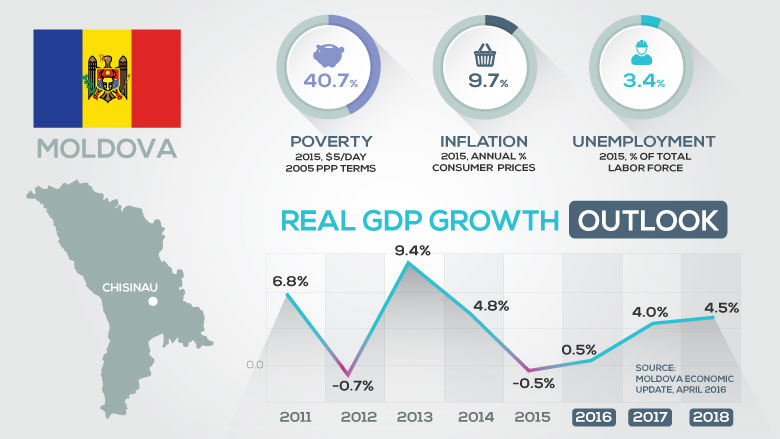Statistics | Economy | Our Partnership | Projects | Research
Statistics
| Moldova | 2015 |
| Population, million | 3.5 |
| GDP, current US$ billion | 6.5 |
| GDP per capita, current US$ | 1828 |
| Poverty rate ($2.5/day 2005PPP terms) | 2.9 |
| Poverty rate ($5/day 2005PPP terms) | 40.7 |
| Gini Coefficient | 26.8 |
| School enrollment, primary (% gross) | 93.8 |
| Life Expectancy at birth, years | 68.7 |
Economy
Recent Developments | Outlook | Risks and Challenges
The economy flipped into recession in the second half of 2015 due to a drought, weak external flows, repercussions of a large scale bank fraud, and tight monetary policy. Amid political instability since 2014 and bank fraud, the economy grew 3.6 percent in the first half of 2015.
However, severe drought and weaker domestic activity, reflecting tighter monetary policy and fiscal squeeze, offset the positive contribution from net exports. As a result, real GDP declined 0.5 percent in 2015. After the government guaranteed deposits in 3 insolvent banks with a total cost of 12 percent of GDP, monetary policy responded aggressively to higher inflation.
The National Bank raised the base interest rate to a record high of 19.5 percent, virtually stopping credit growth. Twelve-month inflation almost doubled to 9.7 percent on average in 2015, nonetheless. Remittances dropped sharply in 2015, leading to an expansion of the current account deficit to 8.5 percent of GDP from 7.1 percent in 2014. Foreign reserves stabilized after a drop in the first quarter of 2015, settling to the equivalent of 3 months of imports.
Confronted with lower revenues and financing in 2015, the government adjusted expenditures while prioritizing social payments. Reflecting a weaker economy, high interest rates and lower external grants, revenues dropped 6.2 percent in real terms. Expenditure increased 4.5 percent, but were 6.9 percent below planned levels. Since June 2015, the Government has had to freeze procurement of goods and services, and to ration capital expenditures.
As a result, the government maintained the real value of social spending, while capital expenditures faced a double-digit decline. The cash deficit increased to 2.2 percent of GDP, from 1.7 percent a year ago. The already poor performing labor market remained weak in 2015.
Unemployment increased in three out of four quarters, ending at 4.2 percent by the end of 2015. Employment did not catch up with the increase in the labor force, around 3 percent, likely due to the return of people working abroad. Average earnings in 2015 increased slightly in real values (0.7 percent), probably stemming from an increase in self-employment earnings in the non-agricultural sector, counterbalancing the decline in households’ income from employment and agriculture.
A severe summer drought, lower remittances and higher inflation are estimated to have affected living standards in Moldova in 2015, pushing poverty into an upward trend. Poverty had been on the decline for recent years, going from 46.4 percent of the population in 2012 (US$5 per day, 2005 PPP) to an estimated 40.7 percent in 2014.
However, developments throughout the year 2015 are estimated to have halted this downward trend, with poverty estimated to stand at 41.9 percent in 2015. In addition to the impact of a severe summer drought on the agricultural sector, in which many poor are concentrated, the decline in remittances may have pushed some into poverty and increased the depth of poverty for the already poor.
Although only 27 percent of the non-poor received remittances, those who do are highly dependent on them, with remittances accounting for 55 percent of their income. Furthermore, 15 percent of the poor derive more than half of their income from remittances.
The economy is projected to remain subdued in 2016, with growth close to nil. Net exports are expected to be the main growth driver given the exchange rate adjustment and tighter domestic demand policies. Prolonged low remittances and higher costs of domestic financing coupled with lack of investor confidence after the fraud in the banking system will constrain domestic absorption. The budget deficit is expected to increase to 3.2 percent of GDP in 2016.
Accordingly, poverty is expected to decline only modestly in 2016, by less than one percentage point. Remittances are likely to remain at lower levels, inflationary pressures remain and a recovery in labor markets is not expected in the short term. Although fiscal policies have protected social payments, the overall limited fiscal capacity could affect households through other fronts.
Poverty is expected to stand at 41 percent in 2016. As the economy stabilizes and investor confidence improves, Moldova is expected slowly to regain its growth momentum reaching its full potential by 2017-2018; slight reductions in poverty may follow. As inflationary pressures dissipate, consumer prices are projected to decrease to the central bank’s inflation target range of 5±1.5 percent starting in 2017.
Along with the economic recovery, fiscal deficits are likely to decline to 2.5 percent of GDP by 2018. Weaker domestic activity will keep the current account deficit on a gradually declining path. The acceleration in growth is expected to be accompanied by a reduction in poverty to 37.5 percent in 2017 and could reach 33.4 percent in 2018.
Moldova has limited macroeconomic buffers and needs to deal with major governance issues. A flexible exchange rate will help mitigate some of the shocks, but efficient public spending and institutions are the most important elements of macroeconomic stabilization.
Major efforts in regaining the efficiency and credibility of the banking sector, fighting corruption and dealing with governance issues are needed to regain investor and consumer confidence. Moldova faces a need for fiscal consolidation to maintain fiscal sustainability, while protecting the less well-off.
A weaker economy, high interest rates, the fiscal cost of the failed banks and lower external financing exacerbate the immediate fiscal pressures stemming from indexation of social payments. With higher projected public debt and lower external grants and financing, Moldova should concentrate on efficiency gains in public recurrent expenditure and improve governance.
This process needs to take account of the distributional impacts that fiscal measures – either on the revenue or the expenditure side - may have, particularly on the less well-off. Moving forward, strengthening labor markets is critical for growth and poverty reduction. Promoting a sound business environment and improving governance are necessary steps to boost job creation and open up opportunities in the labor market.
Our Partnership
The World Bank Group Country Partnership Strategy for the Republic of Moldova for FY14–17 provides support to help reduce poverty and boost shared prosperity by capturing the full benefits of openness and integration with the EU and the broader global economy through three pillars:
1. Increasing Competitiveness. Continued institutional reform of the business climate and governance, improved access to finance, and activities to improve companies’ competitiveness are needed to reduce barriers and translate economic openness into the concrete benefits of more jobs and higher income.
2. Enhancing Human Capital and Minimizing Social Risks. The widening gap with the EU28 in education and health outcomes should be reduced and progressively closed. Demographic challenges should be addressed. Vulnerabilities should be tackled through strengthened social protection systems.
3. Promoting a Green, Clean, and Resilient Moldova. the debilitating effects of climatic events on agriculture and rural livelihoods need to be addressed for sustainable development. A mid-term CPS review is planned for FY16. The CPS Performance and Learning Review will aim to confirm, together with country authorities, the proposed strategic pillars and make any required adjustments to the lending and analytical program and the results framework through FY17.
The World Bank’s active portfolio includes eight investment projects. Total commitments amount to US$255.3 million. The disbursement ratio for FY15 was 26.8 percent. After turning around 3 problem projects in FY15, only one problem project was left by June 2015: Strengthening the Effectiveness of the Social Safety Net Project (US$37 million IDA, rated moderately unsatisfactory for achievement of its development objective).
Portfolio composition is 96 percent loans and 4 percent equity and quasi-equity. There are currently no nonperforming loans (NPLs) out of a total of 14 projects Active programs focus on: (i) promoting investment climate reform; (ii) building risk and NPL management capacity in the financial sector; and (iii) developing public-private partnerships (PPPs) in health.
A strong emphasis on partnerships with other development partners has proven effective in leveraging substantial co-financing for reforms.
Operations in the Bank’s portfolio have attracted the support of other development partners, including the European Commission (EC), the Global Environment Facility (GEF), the German Development Bank (KFW), the Governments of the Netherlands, Sweden, and Switzerland, the United Nations Children’s Fund (UNICEF), and the U.S. Agency for International Development (USAID), which co-financed IDA operations, financed carbon operations, and provided other forms of support, including for Advisory Services and Analytics (ASA).
Technical assistance and sector support have been provided in agriculture, education, e-transformation, the financial and private sectors, and energy. In energy, several trust funds have provided support to district heating restructuring and reform, informing the design of the District Heating Efficiency Improvement Project (DHEIP), approved in FY15.


